Workplace Law Case Study: Employee vs. Contractor and Unfair Dismissal
VerifiedAdded on 2023/04/25
|8
|2084
|443
Case Study
AI Summary
This case study examines several key issues in workplace law. Firstly, it assesses whether an individual, Bob, is correctly classified as a contractor or an employee, analyzing the application of the multifactor test and the significance of obtaining an ABN. Secondly, the case evaluates the binding nature of employment contract policies on Bob, assuming he is an employee, considering the role of codes of conduct in regulating workplace behavior. Finally, the study determines whether there is a valid reason to support Bob's dismissal, focusing on allegations of sexual harassment and bullying, and considering the implications of misconduct within the workplace. The analysis references relevant legal precedents and legislation, including the Fair Work Act 2009, to provide a comprehensive understanding of the legal principles involved.
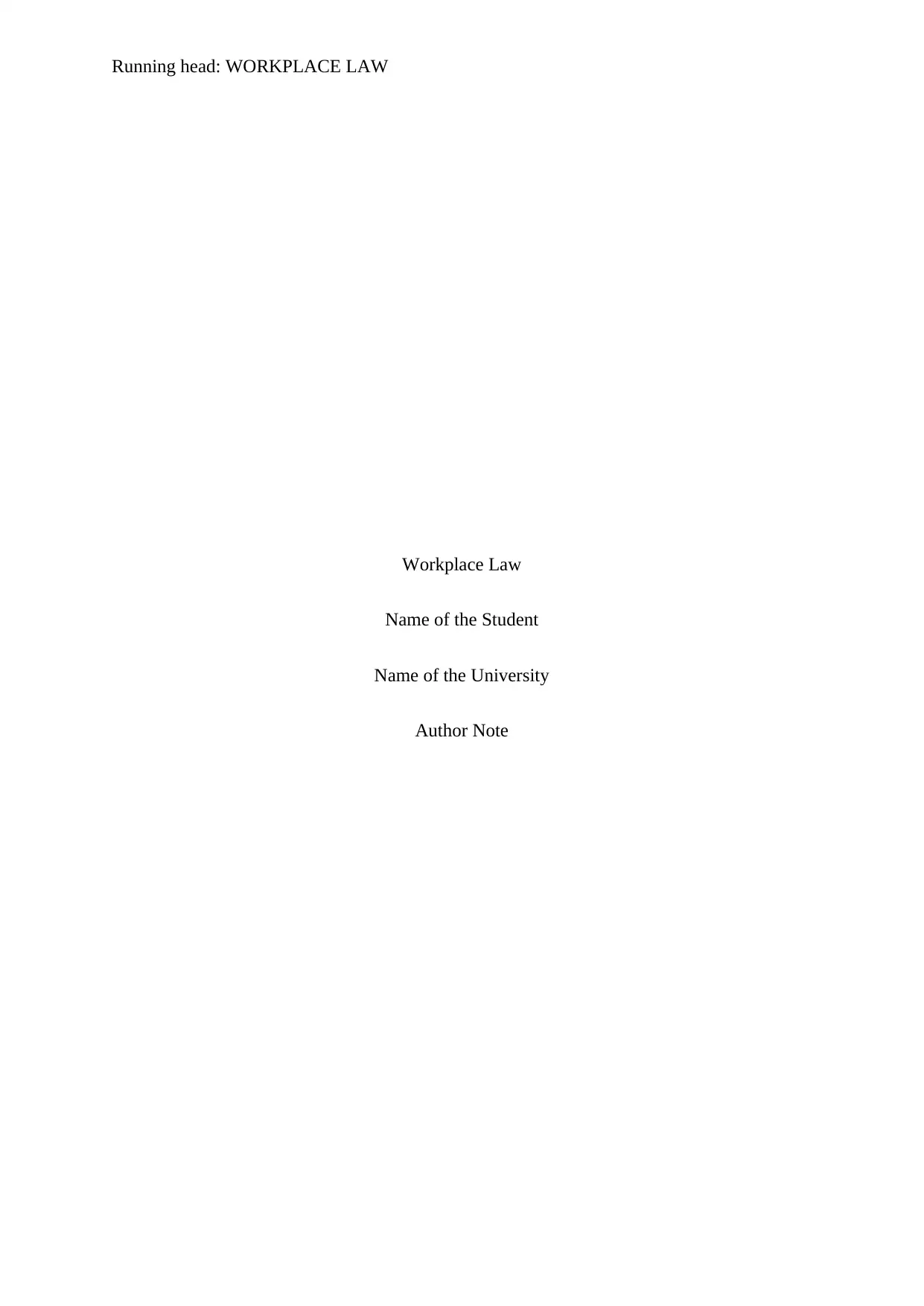
Running head: WORKPLACE LAW
Workplace Law
Name of the Student
Name of the University
Author Note
Workplace Law
Name of the Student
Name of the University
Author Note
Paraphrase This Document
Need a fresh take? Get an instant paraphrase of this document with our AI Paraphraser
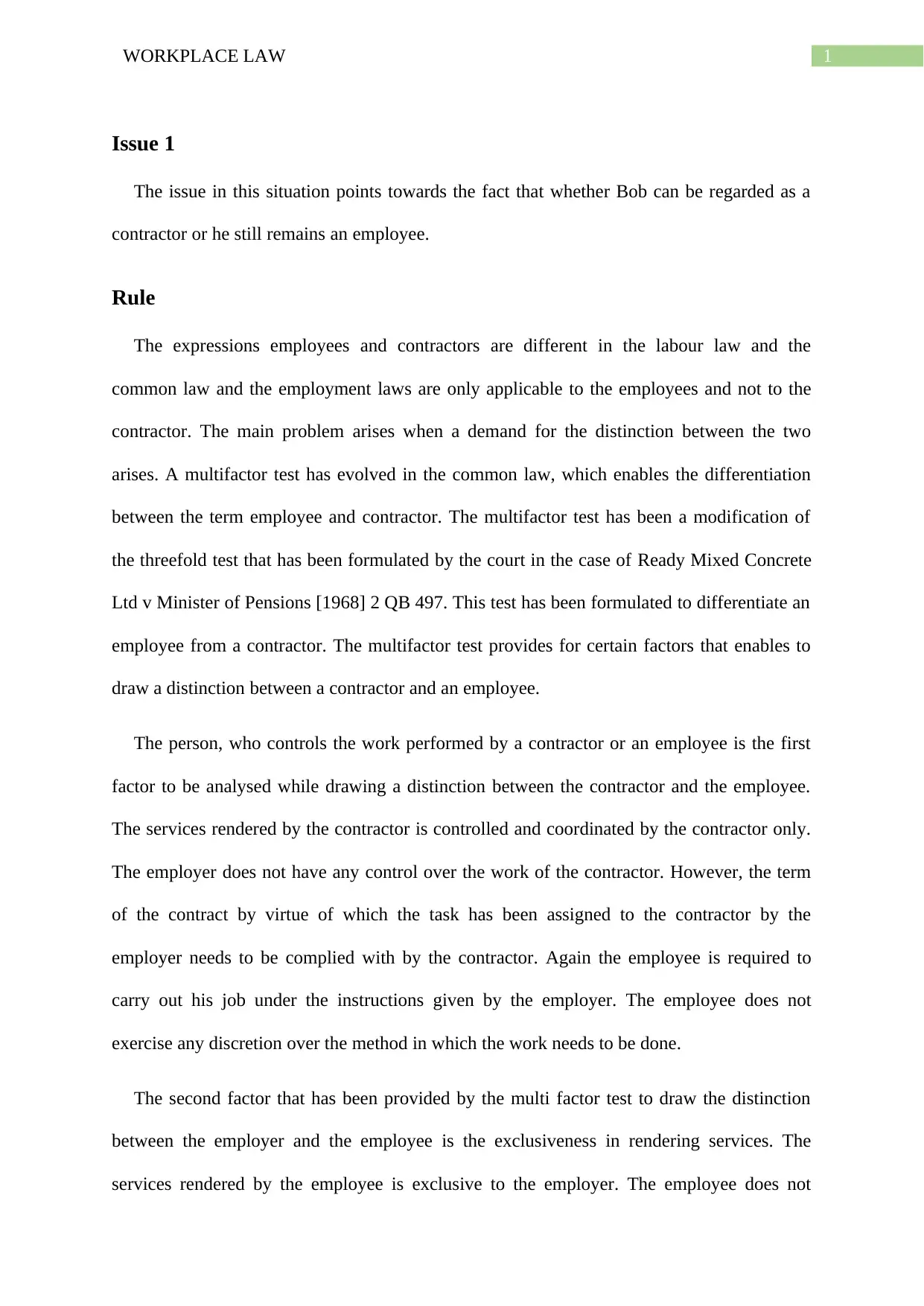
1WORKPLACE LAW
Issue 1
The issue in this situation points towards the fact that whether Bob can be regarded as a
contractor or he still remains an employee.
Rule
The expressions employees and contractors are different in the labour law and the
common law and the employment laws are only applicable to the employees and not to the
contractor. The main problem arises when a demand for the distinction between the two
arises. A multifactor test has evolved in the common law, which enables the differentiation
between the term employee and contractor. The multifactor test has been a modification of
the threefold test that has been formulated by the court in the case of Ready Mixed Concrete
Ltd v Minister of Pensions [1968] 2 QB 497. This test has been formulated to differentiate an
employee from a contractor. The multifactor test provides for certain factors that enables to
draw a distinction between a contractor and an employee.
The person, who controls the work performed by a contractor or an employee is the first
factor to be analysed while drawing a distinction between the contractor and the employee.
The services rendered by the contractor is controlled and coordinated by the contractor only.
The employer does not have any control over the work of the contractor. However, the term
of the contract by virtue of which the task has been assigned to the contractor by the
employer needs to be complied with by the contractor. Again the employee is required to
carry out his job under the instructions given by the employer. The employee does not
exercise any discretion over the method in which the work needs to be done.
The second factor that has been provided by the multi factor test to draw the distinction
between the employer and the employee is the exclusiveness in rendering services. The
services rendered by the employee is exclusive to the employer. The employee does not
Issue 1
The issue in this situation points towards the fact that whether Bob can be regarded as a
contractor or he still remains an employee.
Rule
The expressions employees and contractors are different in the labour law and the
common law and the employment laws are only applicable to the employees and not to the
contractor. The main problem arises when a demand for the distinction between the two
arises. A multifactor test has evolved in the common law, which enables the differentiation
between the term employee and contractor. The multifactor test has been a modification of
the threefold test that has been formulated by the court in the case of Ready Mixed Concrete
Ltd v Minister of Pensions [1968] 2 QB 497. This test has been formulated to differentiate an
employee from a contractor. The multifactor test provides for certain factors that enables to
draw a distinction between a contractor and an employee.
The person, who controls the work performed by a contractor or an employee is the first
factor to be analysed while drawing a distinction between the contractor and the employee.
The services rendered by the contractor is controlled and coordinated by the contractor only.
The employer does not have any control over the work of the contractor. However, the term
of the contract by virtue of which the task has been assigned to the contractor by the
employer needs to be complied with by the contractor. Again the employee is required to
carry out his job under the instructions given by the employer. The employee does not
exercise any discretion over the method in which the work needs to be done.
The second factor that has been provided by the multi factor test to draw the distinction
between the employer and the employee is the exclusiveness in rendering services. The
services rendered by the employee is exclusive to the employer. The employee does not
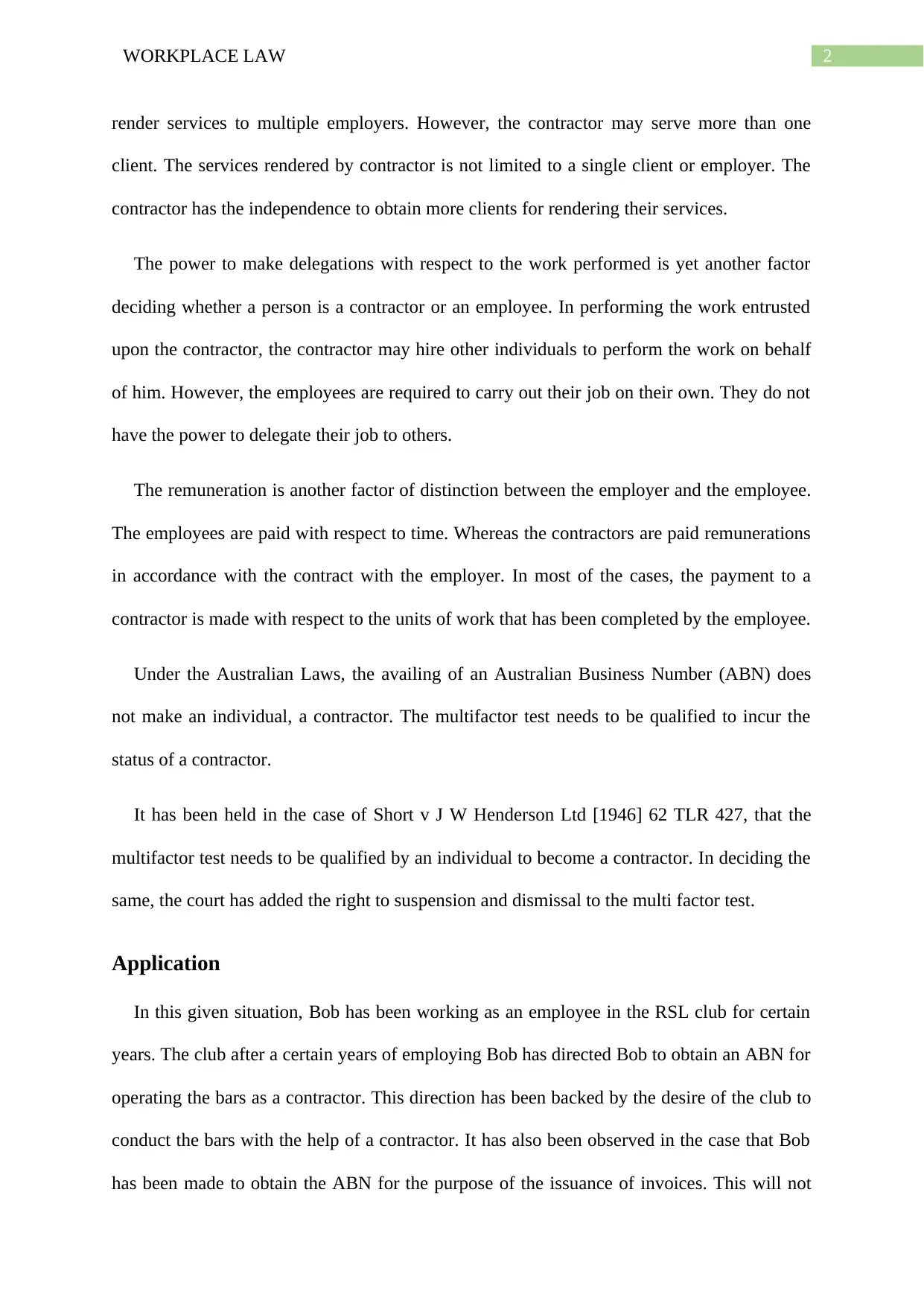
2WORKPLACE LAW
render services to multiple employers. However, the contractor may serve more than one
client. The services rendered by contractor is not limited to a single client or employer. The
contractor has the independence to obtain more clients for rendering their services.
The power to make delegations with respect to the work performed is yet another factor
deciding whether a person is a contractor or an employee. In performing the work entrusted
upon the contractor, the contractor may hire other individuals to perform the work on behalf
of him. However, the employees are required to carry out their job on their own. They do not
have the power to delegate their job to others.
The remuneration is another factor of distinction between the employer and the employee.
The employees are paid with respect to time. Whereas the contractors are paid remunerations
in accordance with the contract with the employer. In most of the cases, the payment to a
contractor is made with respect to the units of work that has been completed by the employee.
Under the Australian Laws, the availing of an Australian Business Number (ABN) does
not make an individual, a contractor. The multifactor test needs to be qualified to incur the
status of a contractor.
It has been held in the case of Short v J W Henderson Ltd [1946] 62 TLR 427, that the
multifactor test needs to be qualified by an individual to become a contractor. In deciding the
same, the court has added the right to suspension and dismissal to the multi factor test.
Application
In this given situation, Bob has been working as an employee in the RSL club for certain
years. The club after a certain years of employing Bob has directed Bob to obtain an ABN for
operating the bars as a contractor. This direction has been backed by the desire of the club to
conduct the bars with the help of a contractor. It has also been observed in the case that Bob
has been made to obtain the ABN for the purpose of the issuance of invoices. This will not
render services to multiple employers. However, the contractor may serve more than one
client. The services rendered by contractor is not limited to a single client or employer. The
contractor has the independence to obtain more clients for rendering their services.
The power to make delegations with respect to the work performed is yet another factor
deciding whether a person is a contractor or an employee. In performing the work entrusted
upon the contractor, the contractor may hire other individuals to perform the work on behalf
of him. However, the employees are required to carry out their job on their own. They do not
have the power to delegate their job to others.
The remuneration is another factor of distinction between the employer and the employee.
The employees are paid with respect to time. Whereas the contractors are paid remunerations
in accordance with the contract with the employer. In most of the cases, the payment to a
contractor is made with respect to the units of work that has been completed by the employee.
Under the Australian Laws, the availing of an Australian Business Number (ABN) does
not make an individual, a contractor. The multifactor test needs to be qualified to incur the
status of a contractor.
It has been held in the case of Short v J W Henderson Ltd [1946] 62 TLR 427, that the
multifactor test needs to be qualified by an individual to become a contractor. In deciding the
same, the court has added the right to suspension and dismissal to the multi factor test.
Application
In this given situation, Bob has been working as an employee in the RSL club for certain
years. The club after a certain years of employing Bob has directed Bob to obtain an ABN for
operating the bars as a contractor. This direction has been backed by the desire of the club to
conduct the bars with the help of a contractor. It has also been observed in the case that Bob
has been made to obtain the ABN for the purpose of the issuance of invoices. This will not
⊘ This is a preview!⊘
Do you want full access?
Subscribe today to unlock all pages.

Trusted by 1+ million students worldwide
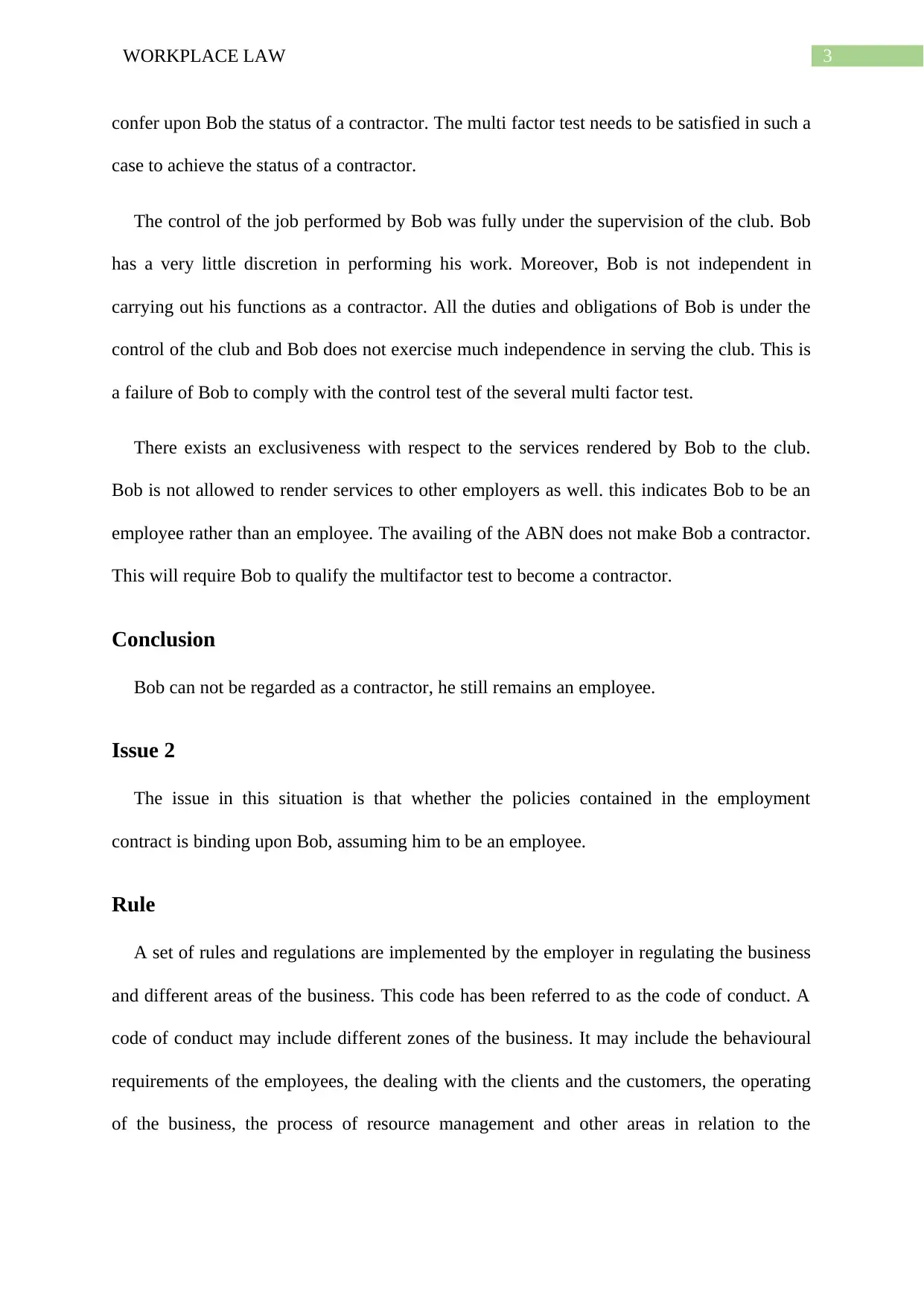
3WORKPLACE LAW
confer upon Bob the status of a contractor. The multi factor test needs to be satisfied in such a
case to achieve the status of a contractor.
The control of the job performed by Bob was fully under the supervision of the club. Bob
has a very little discretion in performing his work. Moreover, Bob is not independent in
carrying out his functions as a contractor. All the duties and obligations of Bob is under the
control of the club and Bob does not exercise much independence in serving the club. This is
a failure of Bob to comply with the control test of the several multi factor test.
There exists an exclusiveness with respect to the services rendered by Bob to the club.
Bob is not allowed to render services to other employers as well. this indicates Bob to be an
employee rather than an employee. The availing of the ABN does not make Bob a contractor.
This will require Bob to qualify the multifactor test to become a contractor.
Conclusion
Bob can not be regarded as a contractor, he still remains an employee.
Issue 2
The issue in this situation is that whether the policies contained in the employment
contract is binding upon Bob, assuming him to be an employee.
Rule
A set of rules and regulations are implemented by the employer in regulating the business
and different areas of the business. This code has been referred to as the code of conduct. A
code of conduct may include different zones of the business. It may include the behavioural
requirements of the employees, the dealing with the clients and the customers, the operating
of the business, the process of resource management and other areas in relation to the
confer upon Bob the status of a contractor. The multi factor test needs to be satisfied in such a
case to achieve the status of a contractor.
The control of the job performed by Bob was fully under the supervision of the club. Bob
has a very little discretion in performing his work. Moreover, Bob is not independent in
carrying out his functions as a contractor. All the duties and obligations of Bob is under the
control of the club and Bob does not exercise much independence in serving the club. This is
a failure of Bob to comply with the control test of the several multi factor test.
There exists an exclusiveness with respect to the services rendered by Bob to the club.
Bob is not allowed to render services to other employers as well. this indicates Bob to be an
employee rather than an employee. The availing of the ABN does not make Bob a contractor.
This will require Bob to qualify the multifactor test to become a contractor.
Conclusion
Bob can not be regarded as a contractor, he still remains an employee.
Issue 2
The issue in this situation is that whether the policies contained in the employment
contract is binding upon Bob, assuming him to be an employee.
Rule
A set of rules and regulations are implemented by the employer in regulating the business
and different areas of the business. This code has been referred to as the code of conduct. A
code of conduct may include different zones of the business. It may include the behavioural
requirements of the employees, the dealing with the clients and the customers, the operating
of the business, the process of resource management and other areas in relation to the
Paraphrase This Document
Need a fresh take? Get an instant paraphrase of this document with our AI Paraphraser
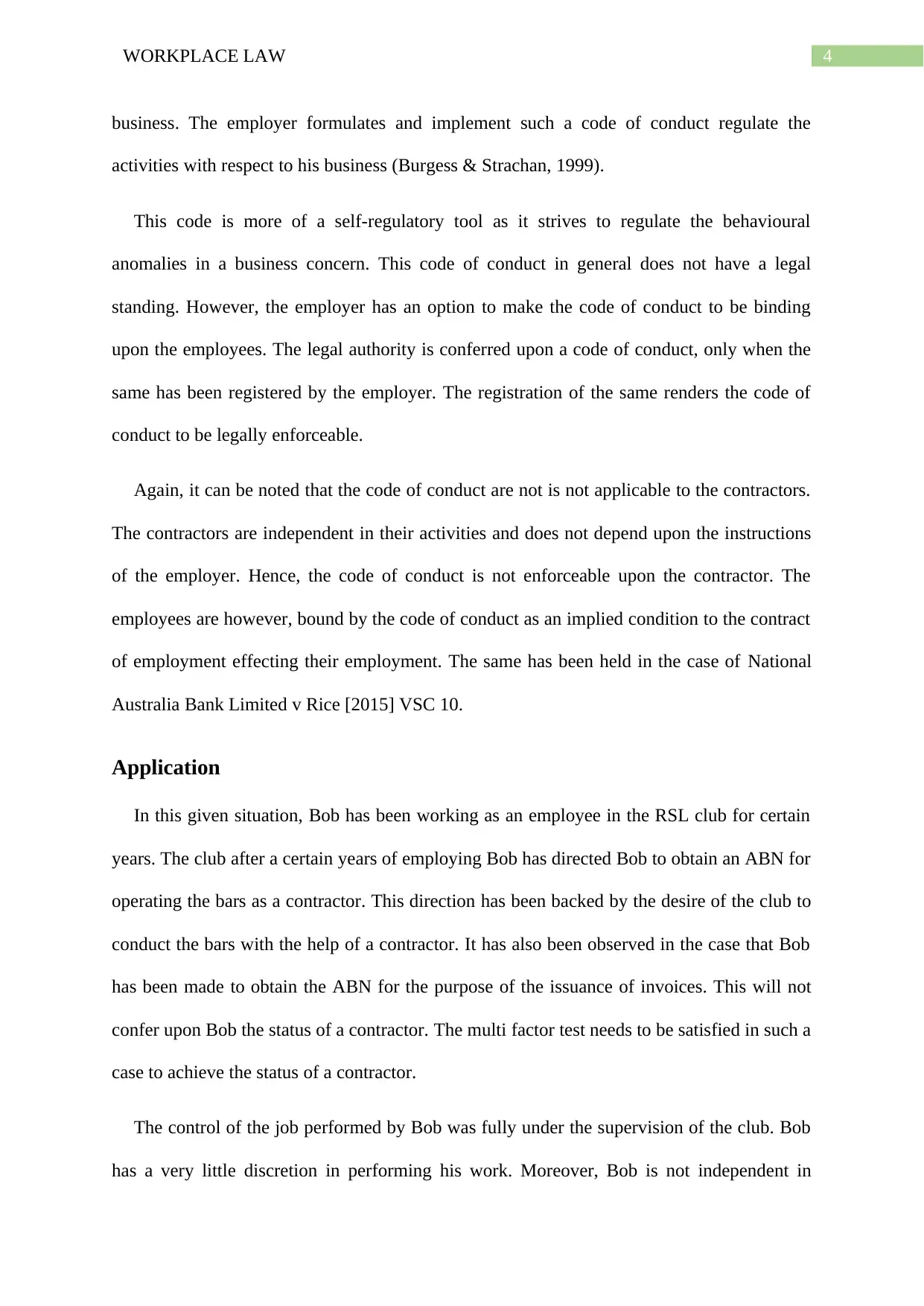
4WORKPLACE LAW
business. The employer formulates and implement such a code of conduct regulate the
activities with respect to his business (Burgess & Strachan, 1999).
This code is more of a self-regulatory tool as it strives to regulate the behavioural
anomalies in a business concern. This code of conduct in general does not have a legal
standing. However, the employer has an option to make the code of conduct to be binding
upon the employees. The legal authority is conferred upon a code of conduct, only when the
same has been registered by the employer. The registration of the same renders the code of
conduct to be legally enforceable.
Again, it can be noted that the code of conduct are not is not applicable to the contractors.
The contractors are independent in their activities and does not depend upon the instructions
of the employer. Hence, the code of conduct is not enforceable upon the contractor. The
employees are however, bound by the code of conduct as an implied condition to the contract
of employment effecting their employment. The same has been held in the case of National
Australia Bank Limited v Rice [2015] VSC 10.
Application
In this given situation, Bob has been working as an employee in the RSL club for certain
years. The club after a certain years of employing Bob has directed Bob to obtain an ABN for
operating the bars as a contractor. This direction has been backed by the desire of the club to
conduct the bars with the help of a contractor. It has also been observed in the case that Bob
has been made to obtain the ABN for the purpose of the issuance of invoices. This will not
confer upon Bob the status of a contractor. The multi factor test needs to be satisfied in such a
case to achieve the status of a contractor.
The control of the job performed by Bob was fully under the supervision of the club. Bob
has a very little discretion in performing his work. Moreover, Bob is not independent in
business. The employer formulates and implement such a code of conduct regulate the
activities with respect to his business (Burgess & Strachan, 1999).
This code is more of a self-regulatory tool as it strives to regulate the behavioural
anomalies in a business concern. This code of conduct in general does not have a legal
standing. However, the employer has an option to make the code of conduct to be binding
upon the employees. The legal authority is conferred upon a code of conduct, only when the
same has been registered by the employer. The registration of the same renders the code of
conduct to be legally enforceable.
Again, it can be noted that the code of conduct are not is not applicable to the contractors.
The contractors are independent in their activities and does not depend upon the instructions
of the employer. Hence, the code of conduct is not enforceable upon the contractor. The
employees are however, bound by the code of conduct as an implied condition to the contract
of employment effecting their employment. The same has been held in the case of National
Australia Bank Limited v Rice [2015] VSC 10.
Application
In this given situation, Bob has been working as an employee in the RSL club for certain
years. The club after a certain years of employing Bob has directed Bob to obtain an ABN for
operating the bars as a contractor. This direction has been backed by the desire of the club to
conduct the bars with the help of a contractor. It has also been observed in the case that Bob
has been made to obtain the ABN for the purpose of the issuance of invoices. This will not
confer upon Bob the status of a contractor. The multi factor test needs to be satisfied in such a
case to achieve the status of a contractor.
The control of the job performed by Bob was fully under the supervision of the club. Bob
has a very little discretion in performing his work. Moreover, Bob is not independent in
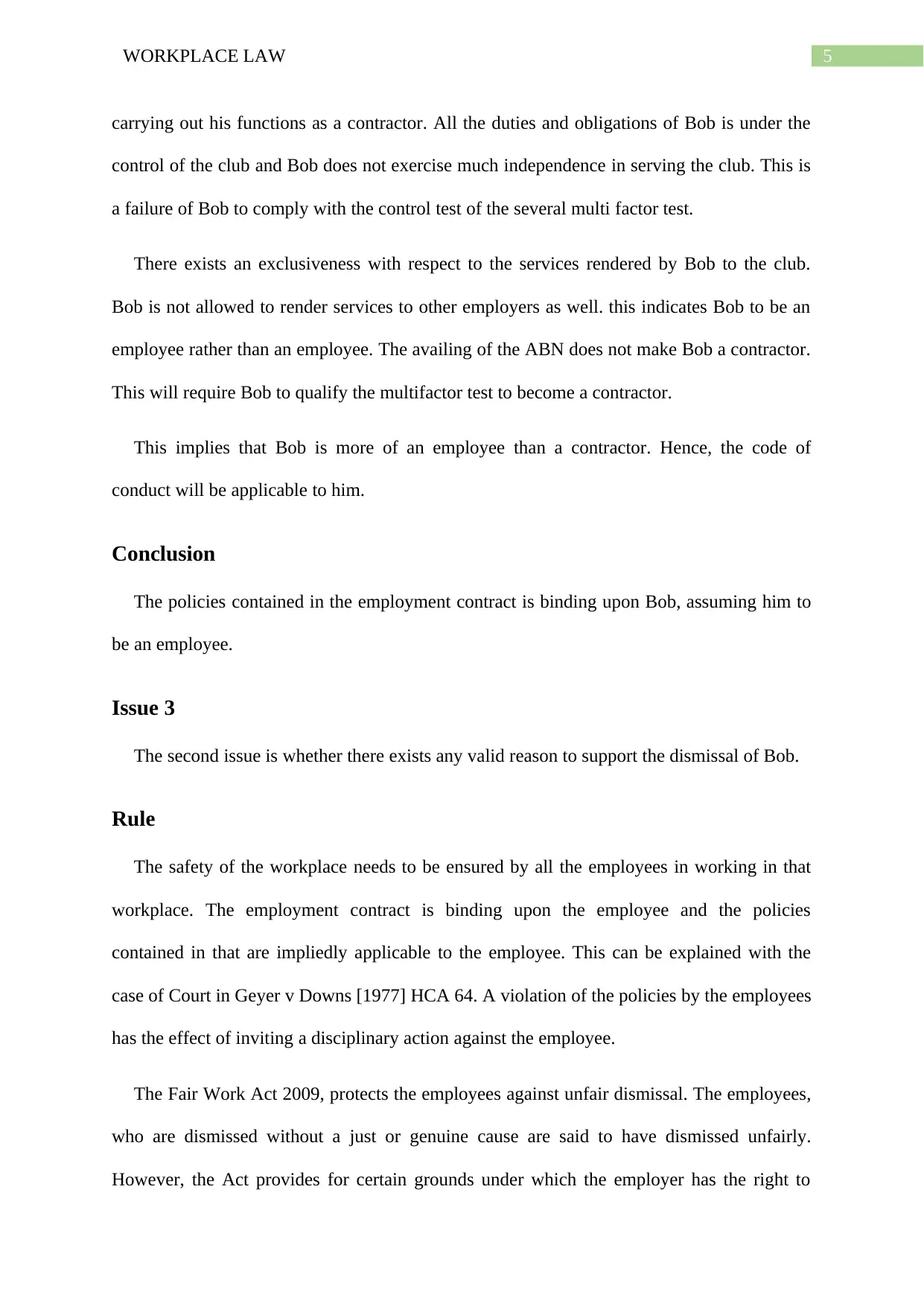
5WORKPLACE LAW
carrying out his functions as a contractor. All the duties and obligations of Bob is under the
control of the club and Bob does not exercise much independence in serving the club. This is
a failure of Bob to comply with the control test of the several multi factor test.
There exists an exclusiveness with respect to the services rendered by Bob to the club.
Bob is not allowed to render services to other employers as well. this indicates Bob to be an
employee rather than an employee. The availing of the ABN does not make Bob a contractor.
This will require Bob to qualify the multifactor test to become a contractor.
This implies that Bob is more of an employee than a contractor. Hence, the code of
conduct will be applicable to him.
Conclusion
The policies contained in the employment contract is binding upon Bob, assuming him to
be an employee.
Issue 3
The second issue is whether there exists any valid reason to support the dismissal of Bob.
Rule
The safety of the workplace needs to be ensured by all the employees in working in that
workplace. The employment contract is binding upon the employee and the policies
contained in that are impliedly applicable to the employee. This can be explained with the
case of Court in Geyer v Downs [1977] HCA 64. A violation of the policies by the employees
has the effect of inviting a disciplinary action against the employee.
The Fair Work Act 2009, protects the employees against unfair dismissal. The employees,
who are dismissed without a just or genuine cause are said to have dismissed unfairly.
However, the Act provides for certain grounds under which the employer has the right to
carrying out his functions as a contractor. All the duties and obligations of Bob is under the
control of the club and Bob does not exercise much independence in serving the club. This is
a failure of Bob to comply with the control test of the several multi factor test.
There exists an exclusiveness with respect to the services rendered by Bob to the club.
Bob is not allowed to render services to other employers as well. this indicates Bob to be an
employee rather than an employee. The availing of the ABN does not make Bob a contractor.
This will require Bob to qualify the multifactor test to become a contractor.
This implies that Bob is more of an employee than a contractor. Hence, the code of
conduct will be applicable to him.
Conclusion
The policies contained in the employment contract is binding upon Bob, assuming him to
be an employee.
Issue 3
The second issue is whether there exists any valid reason to support the dismissal of Bob.
Rule
The safety of the workplace needs to be ensured by all the employees in working in that
workplace. The employment contract is binding upon the employee and the policies
contained in that are impliedly applicable to the employee. This can be explained with the
case of Court in Geyer v Downs [1977] HCA 64. A violation of the policies by the employees
has the effect of inviting a disciplinary action against the employee.
The Fair Work Act 2009, protects the employees against unfair dismissal. The employees,
who are dismissed without a just or genuine cause are said to have dismissed unfairly.
However, the Act provides for certain grounds under which the employer has the right to
⊘ This is a preview!⊘
Do you want full access?
Subscribe today to unlock all pages.

Trusted by 1+ million students worldwide
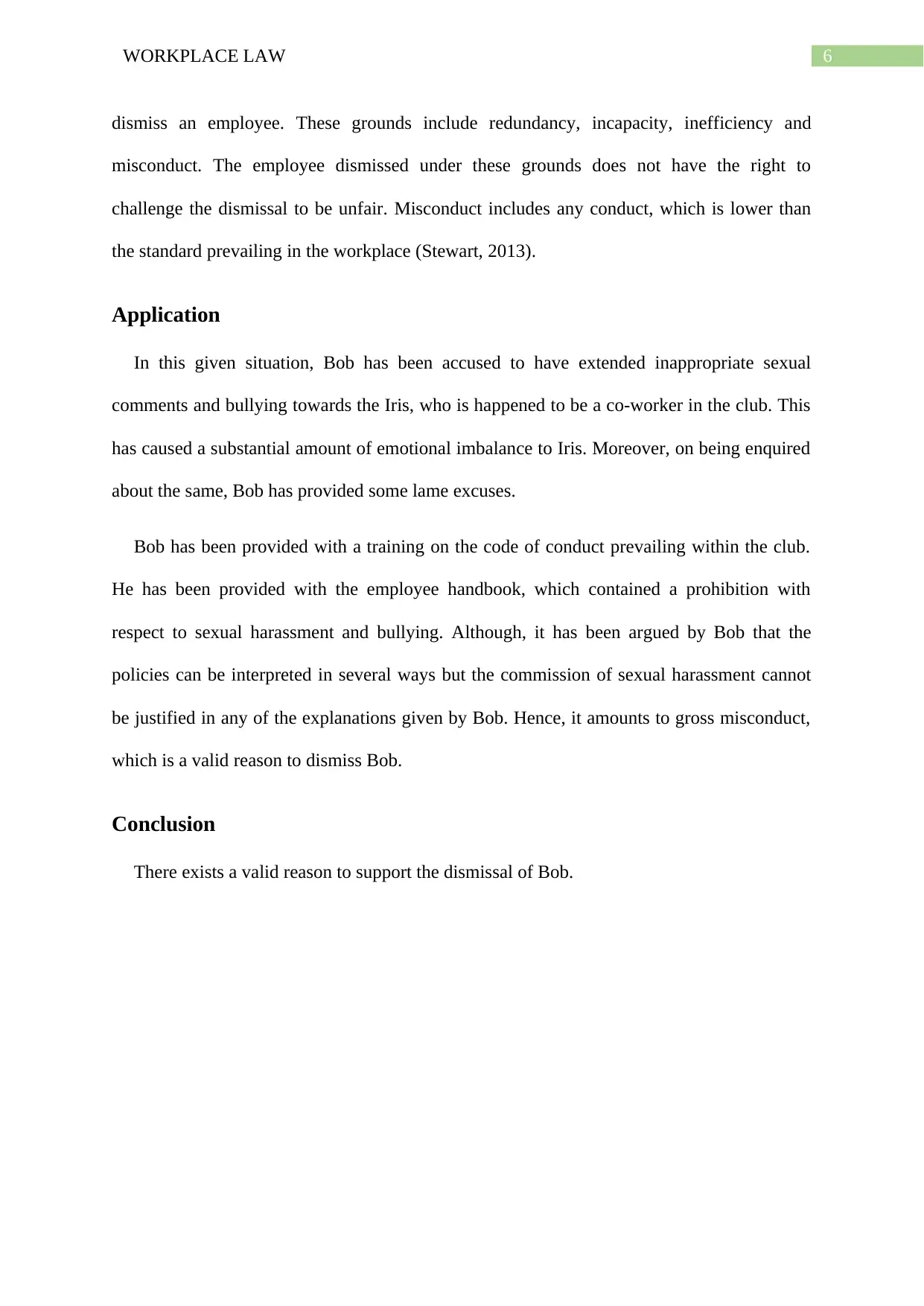
6WORKPLACE LAW
dismiss an employee. These grounds include redundancy, incapacity, inefficiency and
misconduct. The employee dismissed under these grounds does not have the right to
challenge the dismissal to be unfair. Misconduct includes any conduct, which is lower than
the standard prevailing in the workplace (Stewart, 2013).
Application
In this given situation, Bob has been accused to have extended inappropriate sexual
comments and bullying towards the Iris, who is happened to be a co-worker in the club. This
has caused a substantial amount of emotional imbalance to Iris. Moreover, on being enquired
about the same, Bob has provided some lame excuses.
Bob has been provided with a training on the code of conduct prevailing within the club.
He has been provided with the employee handbook, which contained a prohibition with
respect to sexual harassment and bullying. Although, it has been argued by Bob that the
policies can be interpreted in several ways but the commission of sexual harassment cannot
be justified in any of the explanations given by Bob. Hence, it amounts to gross misconduct,
which is a valid reason to dismiss Bob.
Conclusion
There exists a valid reason to support the dismissal of Bob.
dismiss an employee. These grounds include redundancy, incapacity, inefficiency and
misconduct. The employee dismissed under these grounds does not have the right to
challenge the dismissal to be unfair. Misconduct includes any conduct, which is lower than
the standard prevailing in the workplace (Stewart, 2013).
Application
In this given situation, Bob has been accused to have extended inappropriate sexual
comments and bullying towards the Iris, who is happened to be a co-worker in the club. This
has caused a substantial amount of emotional imbalance to Iris. Moreover, on being enquired
about the same, Bob has provided some lame excuses.
Bob has been provided with a training on the code of conduct prevailing within the club.
He has been provided with the employee handbook, which contained a prohibition with
respect to sexual harassment and bullying. Although, it has been argued by Bob that the
policies can be interpreted in several ways but the commission of sexual harassment cannot
be justified in any of the explanations given by Bob. Hence, it amounts to gross misconduct,
which is a valid reason to dismiss Bob.
Conclusion
There exists a valid reason to support the dismissal of Bob.
Paraphrase This Document
Need a fresh take? Get an instant paraphrase of this document with our AI Paraphraser
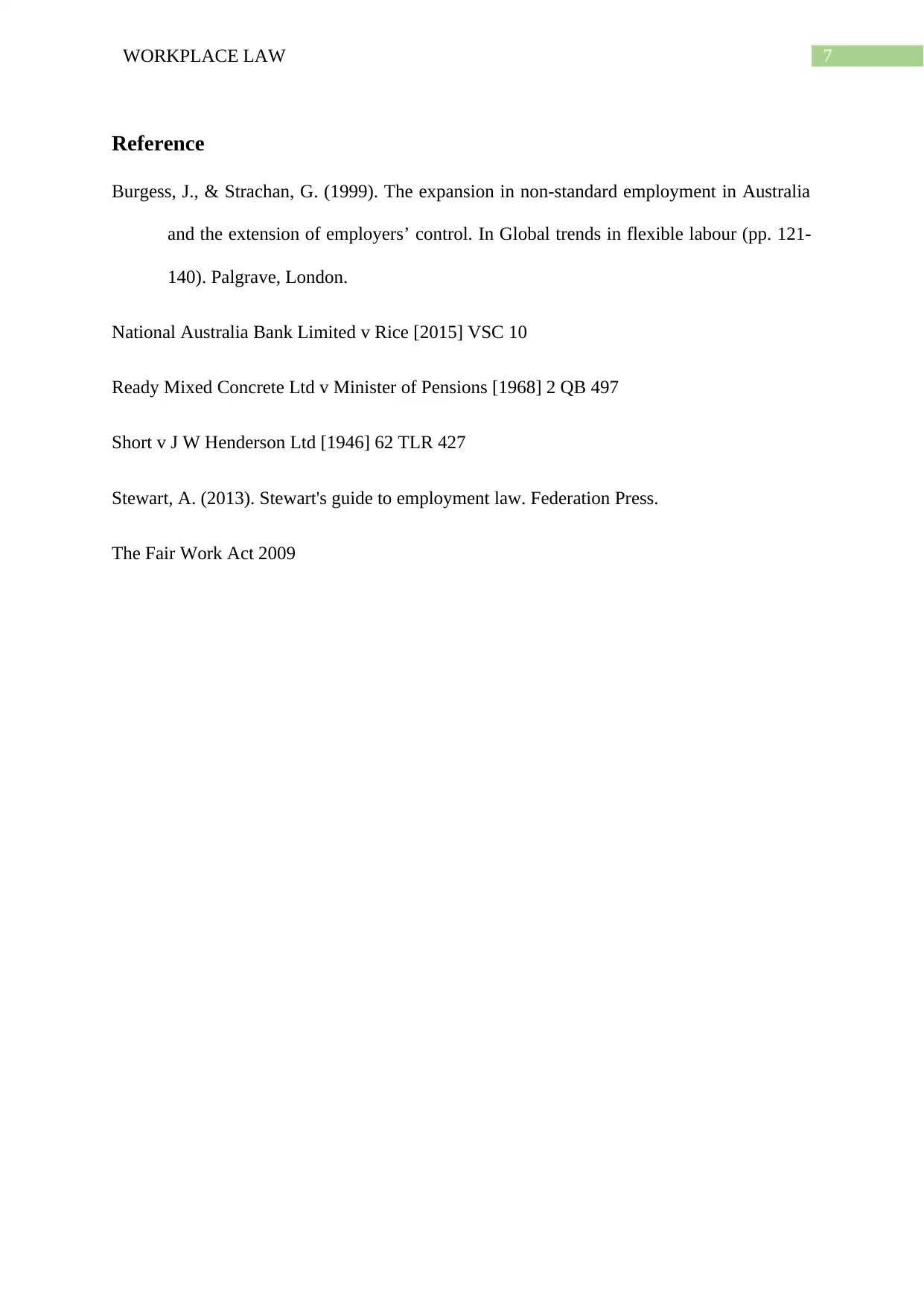
7WORKPLACE LAW
Reference
Burgess, J., & Strachan, G. (1999). The expansion in non-standard employment in Australia
and the extension of employers’ control. In Global trends in flexible labour (pp. 121-
140). Palgrave, London.
National Australia Bank Limited v Rice [2015] VSC 10
Ready Mixed Concrete Ltd v Minister of Pensions [1968] 2 QB 497
Short v J W Henderson Ltd [1946] 62 TLR 427
Stewart, A. (2013). Stewart's guide to employment law. Federation Press.
The Fair Work Act 2009
Reference
Burgess, J., & Strachan, G. (1999). The expansion in non-standard employment in Australia
and the extension of employers’ control. In Global trends in flexible labour (pp. 121-
140). Palgrave, London.
National Australia Bank Limited v Rice [2015] VSC 10
Ready Mixed Concrete Ltd v Minister of Pensions [1968] 2 QB 497
Short v J W Henderson Ltd [1946] 62 TLR 427
Stewart, A. (2013). Stewart's guide to employment law. Federation Press.
The Fair Work Act 2009
1 out of 8
Related Documents
Your All-in-One AI-Powered Toolkit for Academic Success.
+13062052269
info@desklib.com
Available 24*7 on WhatsApp / Email
![[object Object]](/_next/static/media/star-bottom.7253800d.svg)
Unlock your academic potential
Copyright © 2020–2025 A2Z Services. All Rights Reserved. Developed and managed by ZUCOL.





